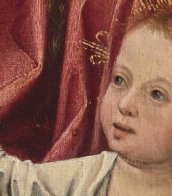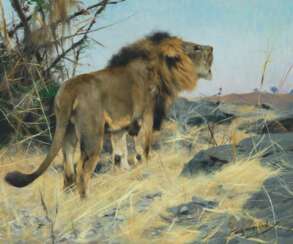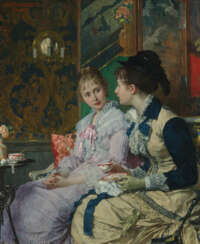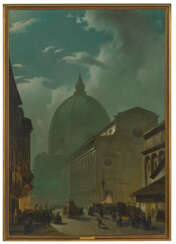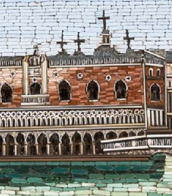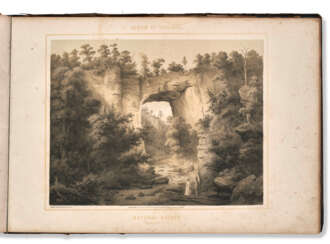german romantic

Friedrich Wilhelm Kuhnert was a German painter, author and illustrator, who specialized in animal images. After illustrating the books of Alfred Brehm, he travelled to German East Africa to observe animals in their habitat and produced numerous paintings that defined Africa for many Germans of the period.


Anselm Feuerbach was a famous 19th-century German painter, an outstanding master of the historical genre.
Anselm Feuerbach was also a skilful portrait painter, the majority of his paintings are in the style of Neoclassicism. His finest masterpieces are nowadays kept in museums in Germany, and his biography is closely linked to Italy, where the artist lived for a considerable part of his life.


Albert Berg was a German landscape painter and museum director.
Berg was educated in diplomacy and law, and also studied painting and painted landscapes. From his travels to Constantinople, New Granada, Rhodes and Asia Minor, Berg brought back many sketches and notes and published them. He was also a member of the Prussian and German Customs Union's diplomatic expedition to Asia and the Pacific in 1859-1862. This resulted in the publication of a pictorial narrative entitled The Prussian Expedition to East Asia: Views of Japan, China and Siam. This historical work reproduces watercolors, oil paintings, and pen and ink drawings, mostly by Albert Berg. The sheets depict views and scenes of Yeddo, Yokahama, Ikegami, Nagasaki, Tientsin, Beijing, Hong Kong, Macau, Ayudhya and Bangkok, with explanations in German, French and English. The crew also included merchants, geographers and botanists, the draughtsman Wilhelm Heine, and the photographers Karl Bismarck and August Sachtler.
In 1880, Albert Berg was appointed the first director of the Silesian Museum of Fine Arts in Breslau and headed it until his death in 1884.


Anselm Feuerbach was a famous 19th-century German painter, an outstanding master of the historical genre.
Anselm Feuerbach was also a skilful portrait painter, the majority of his paintings are in the style of Neoclassicism. His finest masterpieces are nowadays kept in museums in Germany, and his biography is closely linked to Italy, where the artist lived for a considerable part of his life.
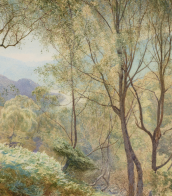

Carl Morgenstern was a German landscape painter of the Romantic period. His father, Johann Friedrich Morgenstern, was an architectural and landscape painter, and Carl received painting and drawing lessons from him at a young age.
At the age of 21 Carl went to Munich and became a pupil of the landscape painter Carl Rottmann. After a three-year stay in Italy, he returned to Frankfurt am Main, where he established himself as an artist and was later appointed professor.
His paintings from the early period mainly show landscapes, which surprise with special light effects and earned him the nickname "Italianist". Despite his desire for artistic innovation, he later devoted himself mainly to repeating popular motifs in order to satisfy his patrons.
Some of his most important works are views of Frankfurt am Main and the city's surroundings, as well as landscapes from the Taunus and along the Rhine.


Salvador Dalí, a Spanish Surrealist painter and printmaker, is celebrated for his vivid and imaginative works that delve into subconscious imagery. Born on May 11, 1904, in Figueres, Catalonia, Spain, Dalí's early exposure to Impressionism and Renaissance masters significantly influenced his artistic development. His education in fine arts in Madrid further shaped his style, leading him to experiment with Cubism and avant-garde movements. In the late 1920s, Dalí embraced Surrealism, joining the Surrealist group in 1929 and rapidly becoming one of its most prominent figures.
Dalí's most famous work, "The Persistence of Memory," completed in 1931, epitomizes the Surrealist movement with its iconic melting clocks symbolizing the fluidity of time. His artistic repertoire was diverse, including painting, graphic arts, film, sculpture, design, and photography, often incorporating themes of dreams, the subconscious, sexuality, religion, and science. Despite his remarkable artistic contributions, Dalí's eccentric and flamboyant public persona often overshadowed his work. He faced criticism for his public support of the Francoist regime and the authenticity of some of his late works.
Dalí's legacy is preserved in major museums, notably the Dalí Theatre-Museum in Figueres and the Salvador Dalí Museum in St. Petersburg, Florida. These institutions showcase his extensive and varied body of work, illustrating his profound impact on Surrealism, pop art, and contemporary artists.
If you're captivated by the surreal world of Salvador Dalí and want to stay informed about new sales and auction events featuring his works, sign up for our updates. Our service is tailored specifically for art collectors and experts, providing timely information and insights into the vibrant market of Dalí's art. Remember, this subscription is focused solely on bringing you the latest in product sales and auction events related to Salvador Dalí. Don't miss out on the opportunity to enrich your collection with pieces from one of the most influential surrealists of all time. Sign up now and be the first to know about these exclusive events.


Ferdinand Johann von Olivier was a German painter, draughtsman, engraver-xylographer and lithographer of the Romantic era. Member of the Olivier family of painters. Worked mainly in the genre of landscape. Artistically, he was close to the Nazarenes.
In 1830, Ferdinand Johann Olivier moved to Munich. There, at the request of Peter von Cornelius, he succeeded Ludwig von Schorn as secretary general of the Munich Academy of Arts. In 1833, Olivier was appointed professor of art history.


Caspar David Friedrich was a German painter of the late eighteenth and first half of the nineteenth centuries. He is known as a painter, draughtsman, watercolorist and is considered a key figure of early German Romanticism.
Caspar David Friedrich was the leader of the so-called Dresden Romantics, known for their emotionally intense landscapes. The artist himself viewed nature as a reflection of the soul and a symbol of religious experiences, creating works with deep symbolism. He actively used landscape to convey his emotions and used the technique of transporting the viewer into the virtual space of the painting. His works often depicted figures immersed in the contemplation of nature, facing infinity, which created a unique effect.


Caspar Johann Nepomuk Scheuren is a German painter and illustrator.
After receiving an elementary art education from his painter father Egidius Scheuren, he studied landscape painting at the Düsseldorf Academy of Art, where he later became a professor.
Caspar Scheuren gradually developed an allegorical style of landscape painting, including motifs from stories and legends of the Rhine. He produced more than 300 oil paintings, 600 watercolors and 400 engravings.
